Tigers In the Wild: Tiger Safaris in India
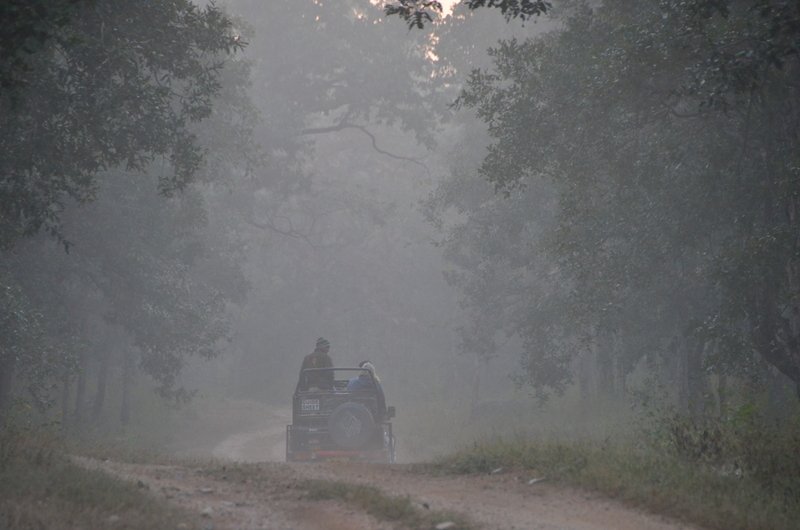
Our driver and guide each lean out of over their jeep doors to scrutinize the dirt road for tracks. “Going this way,” the driver says, pointing, and we continue down a winding lane through teak forest, and Indian ghost trees, peeling and paling through colors as they slowly turn white this time of year. We’ve been bumping around for days, kicking up clouds of dust in an open Maruti Suzuki safari jeep as we ride in back, cold in the morning, covered with blankets and hot water bottles from the lodge. The sun is strong in the afternoon, the dry season offering no cloud protection. No one minds, no one complains; we are caught up in the hunt. We’ve invested time and money to come to Madhya Pradesh, a state in the central highlands of India, to see a very rare creature: the mighty tiger.
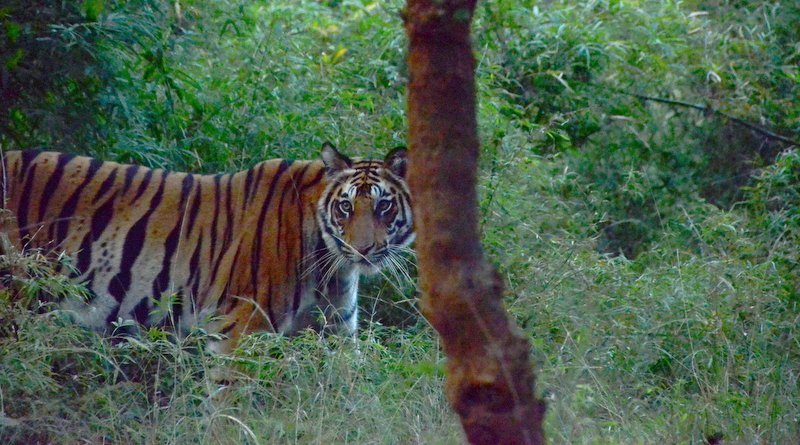
This isn’t the instant gratification of a game drive in the Serengeti, wide open grasslands, herds of elephants, zebras, giraffes and wildebeests, and the likely chance of lions. This is the slow burn. Detective work. A patient hunt. This shouldn’t be surprising; the tiger population in the world has long been declining, from somewhere around 100,000 in the early 20th century to today’s numbers: less than 3,900 (2019) 5,574 (2024) in the world. The largest member of the cat family, the tiger is extinct in several of its native lands and still declining in number elsewhere – except India. Despite the fact that only 11% of its territory remains, India reported a 30% increase in its tiger numbers in 2015. The six designated tiger reserves in Madhya Pradesh are the best bet for spotting one.
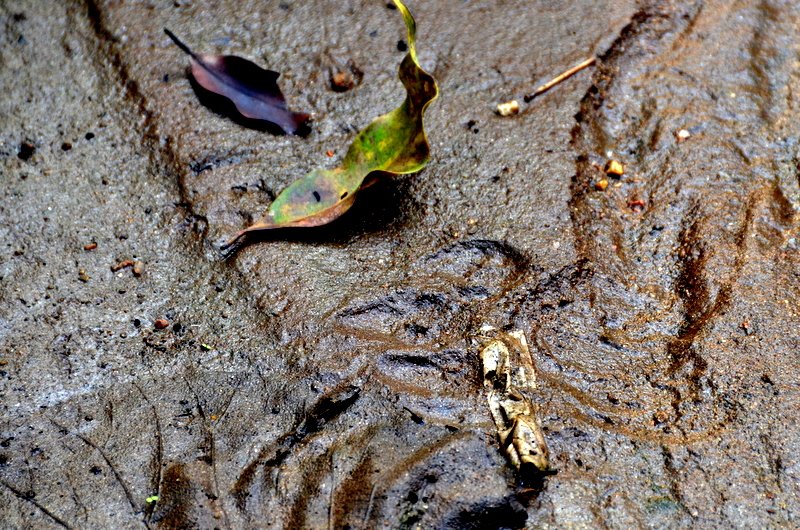
It’s been four days, and all we’ve found are hints and allegations. A paw print in the dust. Scratch marks on a tree. What may have been a roar far off in the distance. The driver stops, kills the engine, as a mahout leans forward on his elephant mount and speaks to the him, points back along the jungle path from where he came. “He says he saw one this morning.” Our guide has keen hearing. Over the whine of the motor and the rattle and creak of the jeep frame as it traverses the rough road, he can hear something in the distance. At a crossroads he stops the jeep, kills the engine again. “There. Warning cries.” Only a couple of us hear it, but as we drive in that direction, it becomes plain: the danger calls of the langurs, black-faced monkeys with tails longer than their bodies. They are the watch guards of the forest; the intensity and frequency of their calls, somewhere between a raspy sneeze and a grunting hiccup, indicate something serious is entering their perimeter, passing beneath the safety of their tree tops. Then there’s the bleat of a samar, a large deer. The smaller spotted deer are spooked, ears turning like parabolic antennas, heads up from the grasses they have stopped chewing. We guess which way the tiger might be moving, he predicts the road it will cross. We wait, and still nothing.
Still, it is remarkable not only that tigers can still be found, but that India has reversed the decline. While poaching and the occasional retaliation killing have not been wiped out entirely, these are no longer the biggest threat to the tiger’s future. The threat now? Other tigers. Tigers are fiercely territorial and, depending on availability of prey, that territory tends to be rather expansive. The male spends a lot of time and energy marking the boundaries, and fights among males can be deadly. The dominant male mates with females in the territory and afterward that female has the challenge of defending those cubs from other males. Competing males kill cubs to make a female able to breed again. A male cub needs to survive at least two years before it might hold its own or challenge an older male for territory. A shift in power means more threats to the most recent litters. In order to minimize this concern, the tigers need more land. With six reserves in Madhya Pradesh already, that is a challenge. Each national park has its primary land, and then extends its reach a bit with “buffer zones,” mostly wild land that may be occupied in some places by local villages, but is no longer open to further development. In some cases, villages are moved out, but not always with the villagers’ blessing.
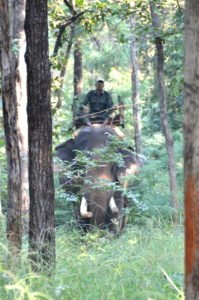 The jeep slows and the driver and guide lean out and points at the soft sand. “There.” The driver turns the jeep around. A fresh print. The tigers like to follow the roads. Even jungle residents prefer a clear path. We stop and talk to a couple of park workers improving one of the roads, remarkably showing up here every day with nothing more than picks, shovels, and bicycles to work out here in tiger territory. Safety in numbers, apparently. They inform our guides that yes, this morning they caught sight of a tiger, moving to the east. We find more prints but from at least last night. A mahout approaches from a forest trail, atop his elephant, quiet with its swaying gait as it moves through the trees, its tusks shorn short for safety. The mahout points back vaguely and our guide translates. “He saw a kill and a mother with two cubs feeding on it.” It’s after 9 am already so our odds of spotting a tiger diminish as they become less active now until the evening. And so it goes.
The jeep slows and the driver and guide lean out and points at the soft sand. “There.” The driver turns the jeep around. A fresh print. The tigers like to follow the roads. Even jungle residents prefer a clear path. We stop and talk to a couple of park workers improving one of the roads, remarkably showing up here every day with nothing more than picks, shovels, and bicycles to work out here in tiger territory. Safety in numbers, apparently. They inform our guides that yes, this morning they caught sight of a tiger, moving to the east. We find more prints but from at least last night. A mahout approaches from a forest trail, atop his elephant, quiet with its swaying gait as it moves through the trees, its tusks shorn short for safety. The mahout points back vaguely and our guide translates. “He saw a kill and a mother with two cubs feeding on it.” It’s after 9 am already so our odds of spotting a tiger diminish as they become less active now until the evening. And so it goes.
We’ve already been to Satpura, where we also had the chance to view wildlife from a canoe, and Pench, where we took a mountain bike tour along a road with tiger and sloth bear tracks. The two gorgeous national parks have varying landscape; Satpura required a boat ride to get to the jeeps at the gate, while Pench featured an impressive ridge in the distance, rising up from teak forest. The bird watching has been excellent, and we’ve seen plenty of monkeys, jackals, wild boars, and various herd animals. One jeep in our group even came upon a leopard for a minute in Satpura. But no tigers. The next day we move to a new lodge and a different park.
Tourism is not the perfect solution for the tigers, but it’s a start. There is still concern about the income not reaching local communities. But efforts are being made to address that. Local guides are assigned to each safari vehicle, and some communities own the only jeeps allowed into the park; resorts must rent them from local operators. Resort development needs to be planned carefully and not willy nilly.
Plus there is the impact on the park and the animals. New rules regarding safari vehicles came into effect on November 1, 2017 and should minimize the stress on both land and wildlife. The park land open to visitors is already only 20% of the total acreage. Now vehicles will be divided up and assigned zones, portions of that 20%, and their location will be monitored by GPS. The maximum speed in the park is 20 kph, and infractions will be punished. In a country not always precise about time, these safari drivers have found punctuality, getting out of the park by their designated time whether they are watching a tiger at the moment or not. These speed and zone limits will also prevent the “feeding frenzy” of two dozen jeeps racing to a reported tiger or leopard sighting.
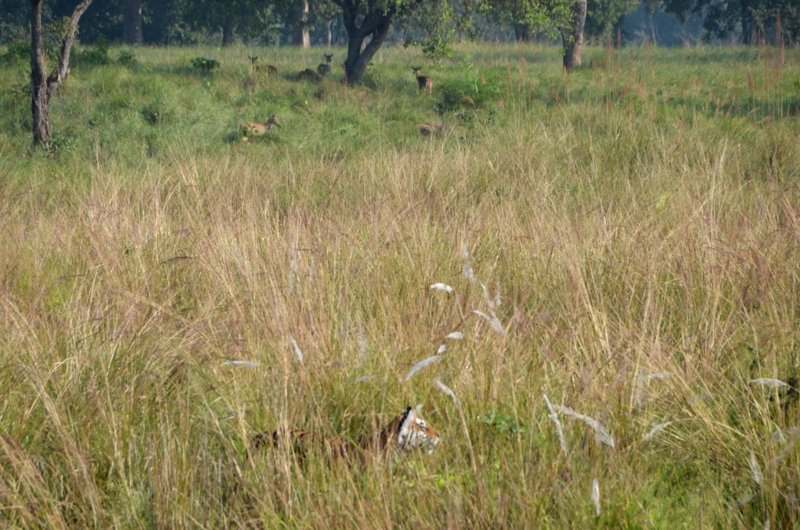
It’s Day Five and we are starting to consider the possibility that on an eight-day tour of we might actually come up empty. Fear not, we are told. Odds increase as we head to Kanha and then Bandhavgarh National Parks.
In Kanha, dim evening is settling in around us as we stop to photograph a rare owl in the branches right above us. We continue down the road a pace, a tall hill shrouded in jungle rises to our right. We come to a narrow grassy clearing that rises up the hill like a ski run. We are thrown a bit when the driver hits the brakes: “There!” he cries. Unaware of the distance beyond his finger tip, our eyes try to focus on something, and after a few seconds I see it 100 meters up, a light patch in the grass. It turns and a pattern of black bars slips off the clearing into the trees.

All decorum is lost and we are children clambering over our seats for a better view, but the driver commands us to sit. In reverse, he moves back to where the owl was and we wait. Another jeep waits at the other end of this stretch of darkening road. Nothing. After 15 minutes, we roll forward to the clearing again. “He will come down,” the guide says with confidence. Fifteen minutes later, he is vindicated. “There!” We point at a hint of movement back where we just were, and again he drives backwards to reach it. We’ve found our tiger. Not only that, but he’s barely off the roadside. Suddenly we are three jeeps in his path, guides hissing commands to drivers and passengers, engines starting and stopping. “A young male,” we are told.
Standing parallel to the road, he almost seems bored as he sizes us up. He takes a few steps through the grass and brush, his muscles quivering beneath his orange and black fur. We are not twenty feet away in an open jeep and the hairs stand up on my arms. We can look right into its eyes, see its whiskers, the white dots on the backs of its ears. No glass partition, no bars, just a tiger, burning bright, free in the forests of the night. Was it worth the wait? The long drives over bumpy roads, the hours traveled to reach the parks? Would it be so exhilarating if we could easily see tigers at every turn? The tiger turns back toward the trees, casts one last look over its shoulder at us, and leaves us, our hearts thumping.
Yes, it was all worth it. Patience. You have to earn it. And a little luck doesn’t hurt either.
Want to See Tigers in India?
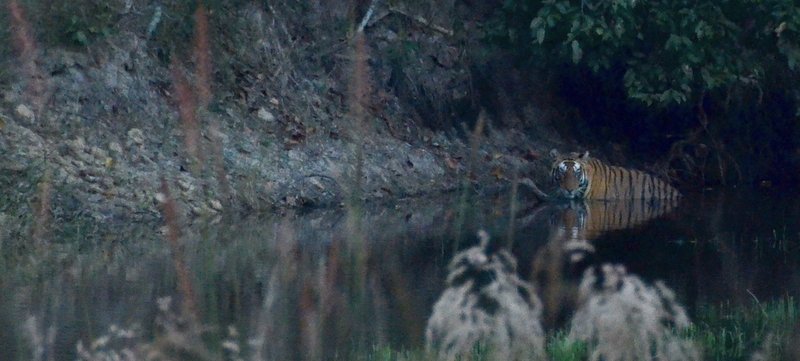
Despite the likelihood and ease of seeing tigers, a trip to Madhya Pradesh is not going to be overwhelmed with tourists. From a report led by Dr. Raghu Chundawat, one of India’s leading wildlife academics and a champion for the tiger: “…the number of international tourists in the state visiting these four Tiger Reserves is in fact very small (5000-6000 visitors) and diminishing.”
My trip in India and the safaris were coordinated and arranged by Royal Expeditions and the lodging was provided by Pugdundee Safaris. I landed in Delhi, traveled by train to Agra for the Taj Mahal, then got back on the train to reach Bhopal, the capital of Madhya Pradesh state. From there Royal Expeditions arranged drivers in a sort of circle tour to the four national parks, with stops at two UNESCO World Heritage Sites: the Paleolithic paintings at Bhimbetka rock shelters and the Kama Sutra-themed sculptures and temple complex at Khajuraho. From Khajuraho airport, I flew back to Delhi.
Check prices on flights to Delhi at:
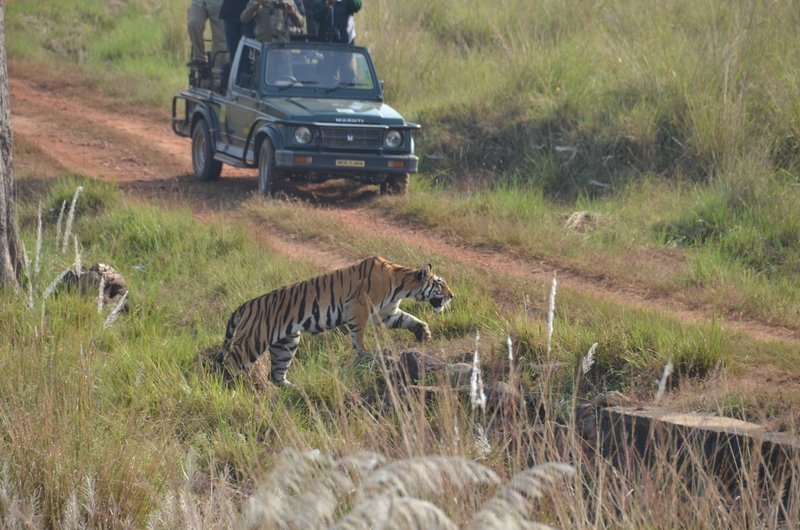
Vishal Singh, the managing director of Royal Expeditions, made an off-the-cuff assessment of our chances of seeing tigers in each of them: Satpura 20%, Pench 40%, Kanha 70%, and Bandhavgarh 90%. My own unscientific analysis would find that a fair assessment. We had two days in each park, with only two four-hour trips into each park (not counting a mountain bike tour in Pench, and a birding safari by canoe in Satpura). A typical traveler would likely want three days and two daily game drives at each park, so odds would increase greatly compared to my own experience (which was already quite awesome).

We didn’t get lucky in the first two parks, though we saw an impressive amount of bird life and other wildlife (and a leopard). But we saw tigers each time we went into Kanha and Bandhavgarh. Only Bandhavgarh didn’t have the new jeep regulations in place yet (but must have by now). The quality of the experience in Kanha seemed better in that respect. More controlled, less crazy. But in either case, the tigers – like the cows throughout India – seem to be well aware of their protected status. Despite the distraction of jeeps and excited guides and visitors, they go about their business, unrushed, unafraid. (An exception may have been a young male we saw at a distance at Kanha, which nevertheless eventually came down the hill and strolled within 20 feet of our vehicle, paused to look us over, then went for a lie down a bit farther up the hill from us.)
Where I Stayed – Safari Lodges in Madhya Pradesh
Denwa Backwater Escape
Satpura National Park
Pench Tree Lodge
Pench National Park
Kanha Earth Lodge
Kanha National Park
Kings Lodge
Bandhavgarh National Park



 ORDER YOUR COPY TODAY!
ORDER YOUR COPY TODAY! ORDER YOUR COPY TODAY!
ORDER YOUR COPY TODAY!
Tiger Safaris looks like quite an adventure!